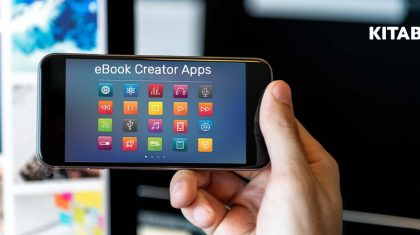
How to Create Engaging and Marketable Teaching Materials for Publication?
Student engagement is paramount when designing educational content, irrespective of changing times. The effectiveness of a lesson hinges on students’ active involvement and attention.
One of the most daunting tasks for educators is crafting materials that both educate and captivate. Striking the right balance is crucial.
To enhance the overall quality of educational materials, educators can incorporate various tools like videos, audio, and interactive elements. In this regard, note that digital publishing platforms, such as KITABOO, offer a seamless solution. They not only streamline content creation but also simplify distribution and licensing.
In this post, we will explore 6 key strategies that will elevate the quality of your teaching materials, making them both engaging for students and attractive for publication.
Table of Contents
I. Types of Teaching Materials Educators Can Choose
II. 6 Key Strategies to Create Engaging and Marketable Teaching Materials for Publication
- Subdivide the Curriculum
- Incorporate a Variety of Learning Styles
- Leverage Innovative Approaches to Deliver Subjective Learning
- Provide Supplemental Support for Special Learners
- Incorporate Interactivity
- Leverage URLs and Outside Resources
III. Wrapping Up
Types of Teaching Materials Educators Can Choose
Today’s educational landscape offers a rich variety of teaching materials. For educators aiming to craft compelling learning experiences, it’s crucial to delve into this diverse range.
Tuning into the preferences of learners and understanding how they best engage with materials can significantly elevate engagement levels.
Outlined below are some of the versatile teaching resources available to educators:
1. Live Sessions
Learners remain more attentive during live sessions as compared to prerecorded sessions. Live sessions require students to be engaged in real time in order to achieve a takeaway from the lesson. To further enhance the outcome of learning, educators can choose to provide a recording of the live session to the students later on.
2. Audio
Audio enhances the accessibility of the online courseware tremendously. For learners who encounter challenges with reading, the inclusion of text-to-speech options allows them to align seamlessly with their peers. This helps educators provide a more equitable distribution of the teaching materials while enhancing engagement.
3. Video
Videos allow students to recover from text-heavy learning and reorient their minds to interact with different types of media. It works to break the monotony of the course and adds visually pleasing aspects to the courseware.
Drawing insights from Chris Andersen of TED Talks, videos that are approximately 18 minutes in length tend to capture and retain attention most effectively. By segmenting courseware into easily digestible 18-20 minute videos, educators can foster a more engaging and accessible learning environment.
6 Key Strategies to Create Engaging and Marketable Teaching Materials for Publication
Student engagement is relatively simple to achieve once the educators understand how best to design the teaching materials.
Listed below are six key strategies that educators can utilize to enhance the engagement of teaching material publications:
1. Subdivide the Curriculum
As discussed earlier, 18 minutes is the optimum time for a video to generate the highest engagement rates. Bite-sized online courseware is easy to remember, recall, and access, and it enables the students to take the course one step at a time.
For example, dividing a 60-minute module into four 15-minute sections helps students feel less intimidated by the course.
2. Incorporate a Variety of Learning Styles
Make the teaching material publishing VARK-friendly. It will not only help to cater to a wider audience but also ensure that all types of learners are engaged effectively.
A highly engaging learning module would consist of all of these learning styles, giving the students better and equitable opportunities to learn. This way, students who learn better visually can stand on an equal footing with those who learn better through reading/writing.
3. Leverage Innovative Approaches to Offer Subjective Learning
Modern technology offers an array of inventive strategies to enrich teaching materials. Features like interactivity, gamification, and animation breathe life into concepts, making them more relatable and digestible.
Beyond mere consumption, these dynamic modules actively invite student participation, transforming passive learners into active participants. By leveraging these innovative tools, educators can sculpt a more personalized and immersive learning journey.
4. Provide Supplemental Support for Special Learners
Not all learners are the same – therefore, the teaching materials published should not be a cookie-cutter thing. This is why educators need to consider adding supplemental learning methods and resources for learners who require additional assistance in using the educational resource or module.
For example, incorporating infographics or text-to-speech versions of the resource helps engage the students who find learning through other means difficult or ineffective.
5. Incorporate Interactivity
Interactivity has proven to be the most effective way of enhancing engagement in educational resources. Consider adding simple recap quizzes to a module to enhance student participation in the publication.
Such quizzes offer the students the chance to go through the lesson in a quick and fun way instead of going through a full-fledged exercise sheet.
6. Leverage URLs and Outside Resources
Adding URLs to third-party resources is a great way to keep a student engaged in learning. It is an excellent way to augment the course with further reading, empowering students to go beyond the formal curriculum and satisfy their curiosity about the subject.
Wrapping Up
Creating engaging and marketable content not only helps educators achieve higher engagement rates but also ensures that students acquire knowledge in a manner that’s both impactful and memorable.
When it comes to teaching materials publishing, by utilizing the capabilities of digital textbook platforms like KITABOO, educators can effortlessly craft hyper-customizable teaching materials.
KITABOO makes it extremely simple to publish, license, and distribute this teaching material at scale and across a wide base. If you are an educator and require enhanced and modernized digital publishing and learning content creation tools, write to us at contact@kitaboo.com to discover how we can elevate your educational offerings.
Connect with our experts for further details!
Suggested Reads:
- Teaching Materials Management Systems
- ePub for Education
- Best Cross-Platform eBook Readers
- Best ePUB Readers for iOS
- Best Ebook Creation Software
- Digital Textbook Platform for K12 Publishers
- Digital Textbook Platform for Associations & Societies
- Digital Textbook Platform for Trade Publishers
- Digital Textbook Platform for Training Companies
- Digital Publishing Solution for Content Aggregators
Discover how a mobile-first training platform can help your organization.
KITABOO is a cloud-based platform to create, deliver & track mobile-first interactive training content.



